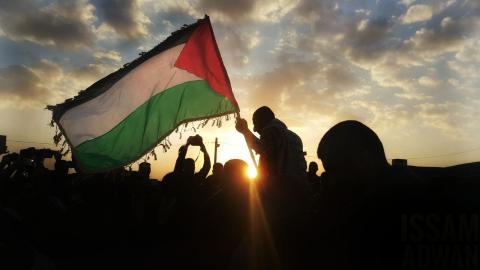For more than 100 days, Palestinians in the Gaza Strip emerged from the shadows of occupation and blockade. Thousands of Palestinians, women and men, old and young, partisans and independent, marched to the barbed-wire fence between the Gaza Strip and Israel and raised their voices. Despite living under blockade and witnessing brutal wars, a majority of the protestors maintained the peaceful and nonviolent nature of the March of Return.

For them, the March was a pivotal moment of raising their voices in a time when they felt that their predicament was risking forgetfulness by the outside world. Right before the March of Return unfolded, the situation Gaza was (and still is) briskly deteriorating.
By participating in the March, Palestinians in Gaza wanted to address their current tragedies, amongst which was the creeping siege that affects almost every aspect of their lives. But by centering the notion of return, they also hoped to shed light on the roots and essence of why the situation in Gaza is in a critical state in the first place.
Since its inception, the Great March of Return was not only met by live fire and tear gas, it was also met with many misconceptions. Smears directed at the March of Return cropped up even before the protests started on Land Day (March 30). They ranged from denying that the Great March of Return was a grassroots protest to bluntly claiming that the entire protest was orchestrated by Hamas. The goal, of course, was to create distractions from what the March was about and busy the media and public opinion with debating whether Hamas orchestrated the March or not.
Organizers of the March from the grassroots in Gaza do recognize of course the challenges that stem from the dominant ruling parties, whether Hamas in the Gaza Strip or the Fateh Palestinian Authority in Ramallah. But evidence has shown that popular and grassroots movements can emerge against all odds, even in the face of the most brutal regimes. Many factors determine the fate and outcomes of such movements: the ways they are received, the ability of their organizers to sustain the achievements of these movements, and whether such movements can successfully bring about change or not.
In the context of the March of Return, the organizers committed themselves to a form of protest (peaceful and nonviolent) that, somehow, assumes a civilized response on the part of the antagonist. Yet, the antagonist, Israel, responded in an extremely violent manner, killing 160 and injuring 12,000, many of them ended with permanent disabilities. Of course, such a scale of crackdown on what its organizers hoped to keep “peaceful and nonviolent” led to a setback. On top of that, Palestinian factional rush to claim and contain the March put the organizers in an awkward place.
The March was and is still a rare opening for many young organizers and activists to reclaim their share of Palestinian politics. For years, the Palestinian political arena has been dominated by factional politics and agendas. The March of Return was a chance for young people to organize and engage in politics in unconventional ways. They organized trips within Gaza to explore its history and experience the open plains near the buffer zone and “border” fence. Moreover, young Palestinians organized reading circles, music and folklore performances, gatherings with elders who shared accounts from the past, and so forth. The March granted its participants a sense of freedom from the chains of organizing in the traditional political arena controlled by factions.
 While the March was a positive opening for many young Palestinians, many factors contributed to the March losing momentum. These factors were, but not limited to, the scale of violence that Israel used to crackdown on the march, the failure on the part of the international community to address the March as a serious political moment (and shift) in Palestinian politics and to view the demands as essential and legitimate foundations for justice, and a fragmented Palestinian political scene.
While the March was a positive opening for many young Palestinians, many factors contributed to the March losing momentum. These factors were, but not limited to, the scale of violence that Israel used to crackdown on the march, the failure on the part of the international community to address the March as a serious political moment (and shift) in Palestinian politics and to view the demands as essential and legitimate foundations for justice, and a fragmented Palestinian political scene.
The failure on the part of the international community to pay heed to Palestinian demands expressed in the March is old news. International inattention to return as key for justice and peace in the region still prevails. The difference, though, is that in the current regional and international moment, grassroots movements are not mostly welcome, whether they are local struggles against oppressive regime or quests for liberation from foreign colonialism and control. After all, Palestinians exist in the same world where counter-revolutionary, far-right, and chauvinistic regimes work endlessly to suppress movements for change and dissent.
Furthermore, the post-World War II order that gave primacy, even if in name only, to human rights and universal values, is less capable of holding violators accountable, let alone Israel, that even in the peak of this order, still managed to escape justice and accountability.
Back to Gaza, it is hard, despite the challenges facing the Great March of Return, to say it is over. In Palestinian history, and in the history of oppressed people and communities, moments of mass mobilization continue despite oppression. Palestinians are human beings, and the level of loss inflicted on them during the March has left them with plenty of mourning and frustration. Yet, Gaza, which was the birthplace of the uprising against refugee resettlement in 1955 and the first Intifada of 1987 will remain a cradle for many significant moments of resistance to come.
Many activists and organizers in the Gaza Strip still persist on carrying on their March. Protestors still gather near the barbed-wire fence almost every Friday. And many of the activities that were overlooked by the media still take place including “Journeys of Return,” a grassroots initiative of organizing trips to various parts of the Strip, including near the buffer zone, where they learn about their land through the lens of arts, history and storytelling, and embracing nature.
What matters at this point is for us, those outside Gaza, to make sure that the sacrifices Palestinians made as part of the March were not made in vain. Palestinians in Gaza cannot be heroes on steroids, they are flesh and blood human beings, not supernormal beings. They were hit by a tragedy, that if happened somewhere else where human life is valued, we would still hear of heart-rending and gut-wrenching accounts about it.
Our role and responsibility are to carry the message of the March of Return, amplify the voices of those who put their lives on the line, and work to end the blockade on Gaza while addressing larger issues such as the centrality of return to bringing justice and peace to this tragic part of the world.

